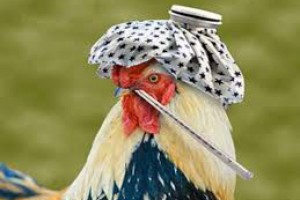An outbreak of bird flu was discovered in the Spassky district of Primorye

Bird flu is an acute viral disease that affects birds and can be transmitted from them to humans. According to the HEAD of the regional state veterinary inspection, Stanislav Krushinsky, its outbreak was identified in the swampy area of the Spassky district. At the moment, the situation is under the control of specialists: “ Quarantine has been introduced in the epizootic outbreak . Private farms do not fall within the five-kilometer threat zone, so poultry will not be confiscated.”
Update 15:50: The area of the outbreak of bird flu is five “squares” of wetlands in the Spassky municipal district. The governor’s order does not specify which settlement this territory and the area within a radius of 5 kilometers, defined as a “threatened zone,” belongs to. The observation zone includes the villages of Novoselskoye, Lebedinoye, Lugovoye, Stepnoye, Gayvoron and Spasskoye, located within a radius of 10 kilometers from the outbreak.
it should be noted that due to the high ability of the virus to change, domestic and wild birds, many species of animals and people suffer from influenza. “Poultry becomes infected from wild waterfowl, which are mostly asymptomatic, but can be a carrier of the virus for a long time, or from birds living near humans (pigeons, crows, sparrows and others). The source of human infection is a sick bird, but transmission of the virus through animals, such as cats, cannot be ruled out,” ROSSELKHOZNADZOR previously reported.
Ways of human infection are contact with sick birds, airborne droplets and nutritional (with food). The secretions of infected birds are dangerous; they, when released into the air and water, can become a source of infection when swimming. The virus can survive in water for up to a month, and even longer at low temperatures. In some cases, a person may become infected by eating MEAT and eggs of sick birds without sufficient heat treatment.
You should not buy poultry meat and eggs in places of unauthorized trade where there are no veterinary laboratories, and also if the products do not have veterinary documents confirming their quality and safety.
Read together with it:
- He crawled to the icon with prayer. The true story of a man who overcame drug addiction.Alexander Ovchinnikov. Topic News. Our project's hero was a drug addict for many years. The thought that this was a dead end never left him, but his addiction proved stronger. One day, when he could no longer walk, he crawled to an icon in prayer. This became his first step toward a new life. Today, he heads a charity center that helps those who have given up hope and are unable to quit ALCOHOL an...
- Низкое предложение и устойчивый спрос: в Аргентине растут цены на мясоЦены на говядину снова выросли, что отразилось на полках супермаркетов и в мясных магазинах. За последние две недели розничные цены выросли на 8–12%, а на некоторые популярные отрубы рост превысил 15% по сравнению с октябрем. Тем не менее, продажи остаются высокими: потребители продолжают покупать, принимая новые цены и закрепляя тенденцию, которая повторяется каждый год в конце года, когда спрос ...
- Смоленская область — лидер России по производству крольчатиныВ интервью «Агроэксперту» заместитель председателя регионального правительства Алексей Кучумов отметил, что регион достиг самодостаточности по таким продуктам, как яйца, мясо и картофель, превышая уровень 100%. Кроме того, Смоленская область занимает первое место по посевным площадям льна, а также активно развивает молочное животноводство, с общим поголовьем более 1......
- Wild boar meat: a sustainable solution for pest controlThis problem isn't unique to our region or country. As veterinarian and specialist Ignacio Zeledon explained, "Where there's water, there are pigs." And the truth is, its spread is noticeable worldwide and represents one of the world's most complex environmental and economic challenges. The wild boar (Sus scrofa) is an invasive alien species, listed among the 1......
- Производство мяса птицы в Новосибирской области увеличилось на 10%Это на 9,7% (или 5,4 тысячи тонн) больше, чем в аналогичном периоде 2024 года, как сообщает Новосибирскстат. Регион занимает второе место по объему производства мяса птицы в Сибирском федеральном округе, уступая лишь Алтайскому краю. Новосибирская область составляет почти 20% от общего производства в округе. Основным продуктом является замороженное мясо сельскохозяйственной птицы, составляющее 5.....




























































